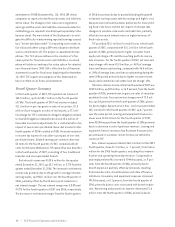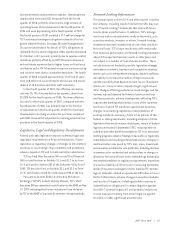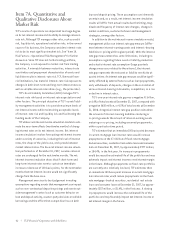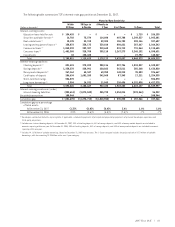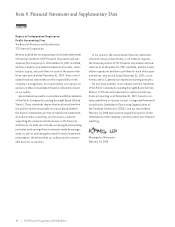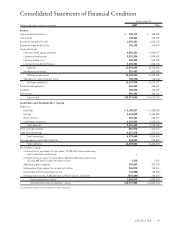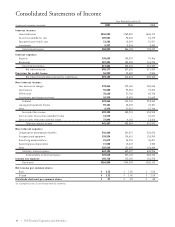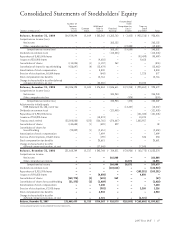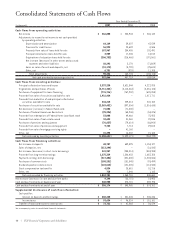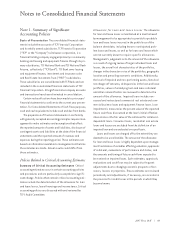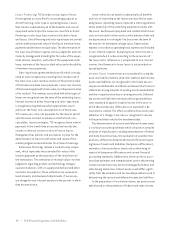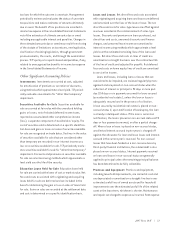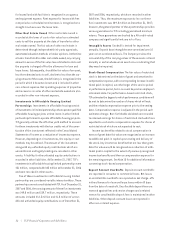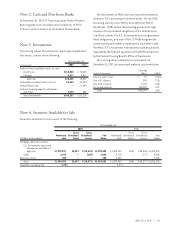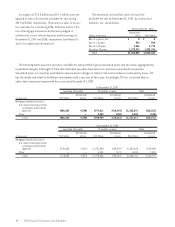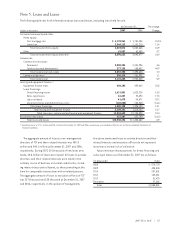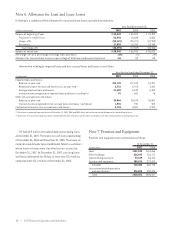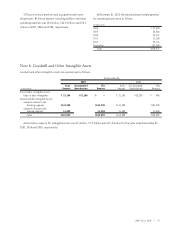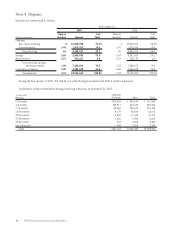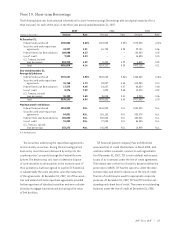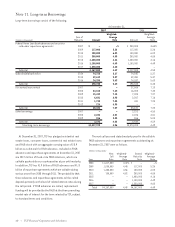TCF Bank 2007 Annual Report Download - page 70
Download and view the complete annual report
Please find page 70 of the 2007 TCF Bank annual report below. You can navigate through the pages in the report by either clicking on the pages listed below, or by using the keyword search tool below to find specific information within the annual report.50 | TCF Financial Corporation and Subsidiaries
Lease Financing TCF provides various types of lease
financing that are classified for accounting purposes as
direct financing, sales-type or operating leases. Leases
that transfer substantially all of the benefits and risks of
equipment ownership to the lessee are classified as direct
financing or sales-type leases and are included in loans
and leases. Direct financing and sales-type leases are carried
at the combined present value of the future minimum lease
payments and the lease residual value. The determination of
the lease classification requires various judgments and esti-
mates by management including the fair value of the equip-
ment at lease inception, useful life of the equipment under
lease, estimate of the lease residual value and collectibility
of minimum lease payments.
Sales-type leases generate dealer profit which is recog-
nized at lease inception by recording lease revenue net of
the lease cost. Lease revenue consists of the present value
of the future minimum lease payments. Lease cost consists
of the leased equipment’s book value, less the present value
of its residual. The revenues associated with other types of
leases are recognized over the term of the underlying leases.
Interest income on direct financing and sales-type leases
is recognized using methods which approximate a level
yield over the fixed, non-cancelable term of the leases.
TCF receives pro-rata rent payments for the interim period
until the lease contract commences and the fixed, non-
cancelable, lease term begins. TCF recognizes these interim
payments in the month they are earned and records the
income in interest income on direct finance leases.
Management has policies and procedures in place for the
determination of lease classification and review of the
related judgments and estimates for all lease financings.
Some lease financings include a residual value compo-
nent, which represents the estimated fair value of the
leased equipment at the expiration of the initial term of
the transaction. The estimation of residual values involves
judgments regarding product and technology changes,
customer behavior, shifts in supply and demand and other
economic assumptions. These estimates are reviewed at
least annually and downward adjustments, if necessary,
are charged to non-interest expense in the periods in which
they become known.
Leases which do not transfer substantially all benefits
and risks of ownership to the lessee are classified as oper-
ating leases. Operating leases represent a rental agreement
where ownership of the underlying equipment resides with
the lessor. Such leased equipment and related initial direct
costs are included in other assets on the balance sheet and
are depreciated on a straight-line basis over the term of
the lease to its estimated salvage value. Depreciation
expense is recorded as operating lease expense and included
in non-interest expense. Operating lease rental income is
recognized when it is due according to the provisions of
the lease and is reflected as a component of non-interest
income. An allowance for lease losses is not provided on
operating leases.
Income Taxes Income taxes are accounted for using the
asset and liability method. Under this method, deferred tax
assets and liabilities are recognized for the future tax con-
sequences attributable to differences between the financial
statement carrying amounts of existing assets and liabilities
and their respective tax-basis carrying amounts. Deferred
tax assets and liabilities are measured using enacted tax
rates expected to apply to taxable income in the years in
which those temporary differences are expected to be
recovered or settled. The effect on deferred tax assets and
liabilities of a change in tax rates is recognized in income
in the period that includes the enactment date.
The determination of current and deferred income taxes
is a critical accounting estimate which is based on complex
analyses of many factors including interpretation of federal
and state income tax laws, the evaluation of uncertain tax
positions, differences between the tax and financial report-
ing bases of assets and liabilities (temporary differences),
estimates of amounts due or owed such as the timing of
reversal of temporary differences and current financial
accounting standards. Additionally, there can be no assur-
ance that estimates and interpretations used in determining
income tax liabilities may not be challenged by federal and
state taxing authorities. Actual results could differ signifi-
cantly from the estimates and tax law interpretations used in
determining the current and deferred income tax liabilities.
In the preparation of income tax returns, tax positions are
taken based on interpretation of federal and state income


